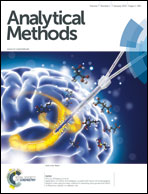Rapid detection of the mature form of cystic fibrosis transmembrane regulator by surface plasmon resonance
Abstract
Cystic fibrosis is the most common lethal autosomal recessive disease in the Caucasian population, and is due to mutations in the cystic fibrosis transmembrane conductance regulator (CFTR) gene. The CFTR protein functions as a chloride channel. Electrophoretic analysis shows that normal CFTR exists in three different molecular weight forms of 127, 131 and 170 kDa (bands A, B and C, respectively) representing different glycosylation forms. Band A is the non-glycosylated form of CFTR, band B is the core-glycosylated CFTR and band C is the mature form of CFTR with complex glycosylation. The glycosylation state of CFTR is representative of its maturation and is an important marker of the protein processing and function. The most common mutation in CF is a missing phenylalanine at position 508 (F508del-CFTR). The misfolded F508del-CFTR protein, which exhibits an altered glycosylation, is observed as bands A and B only and does not traffic correctly to the plasma membrane. Laboratory experiments (SDS-PAGE, immunoblotting, glycosidase digestions, and mobility shift of deglycosylated CFTR) aimed to assess the expression of CFTR and to depict which band is observed have been developed. Nevertheless, these experimental procedures are time consuming and poorly specific. The aim of the present study was to provide an easy, rapid and reproducible methodology to assess whether the CFTR protein within a protein extract is expressed and matured. We show here that surface plasmon resonance (SPR) permits a direct detection of the mature form of CFTR in crude cell lysates, providing a new tool to characterize CFTR in cells without any labelling or pre-treatment before cell lysis. The study of the effects of correctors for F508del-CFTR is the main task of many laboratories. Therefore, the proposed method is likely a useful tool for a rapid detection of mature CFTR in complex samples. We also show here that our method permits the characterization of CFTR in patients' cell extracts in a minimum time.


 Please wait while we load your content...
Please wait while we load your content...